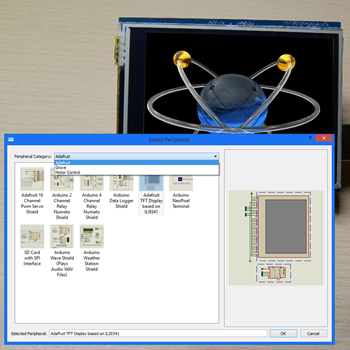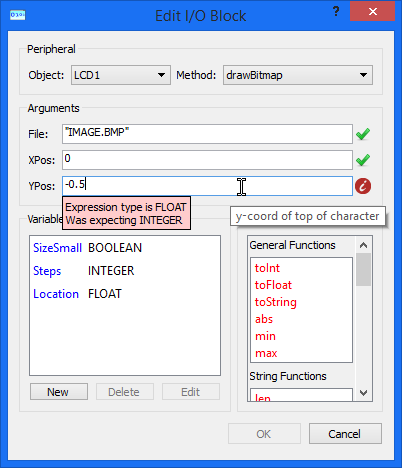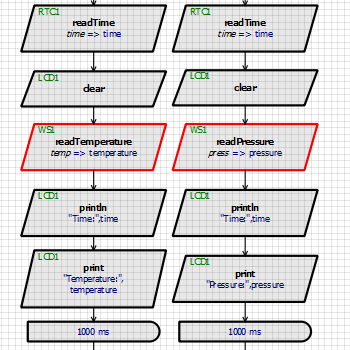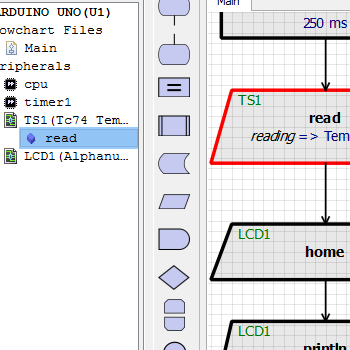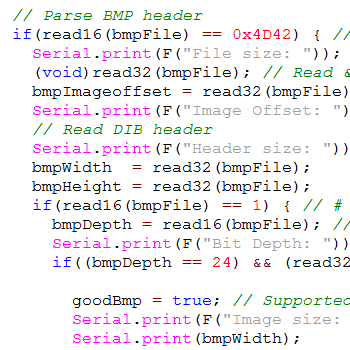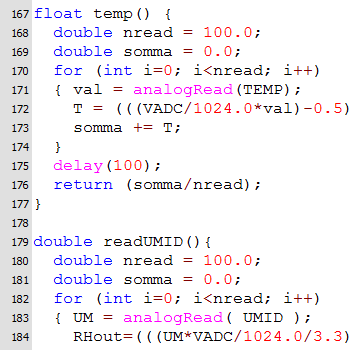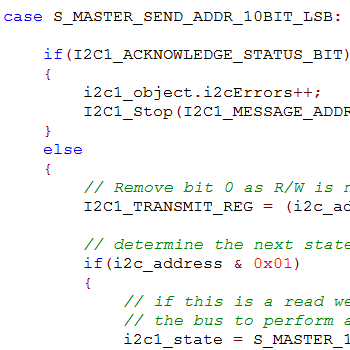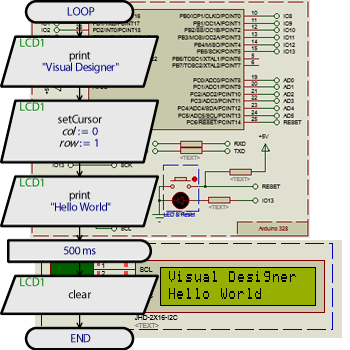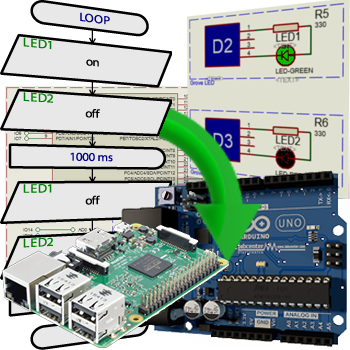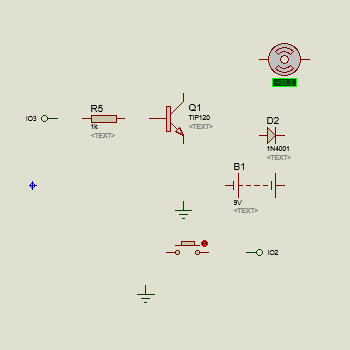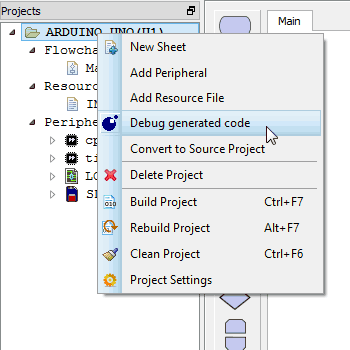What is Proteus Visual Designer?
Proteus Visual Designer combines world class Proteus VSM simulation with an easy to use flowchart editor and a gallery of virtual hardware to provide a truly integrated and intuitive development environment for Arduino and Raspberry Pi.
The peripheral gallery makes hardware design easy. Simply add a shield or sensor from the gallery and Visual Designer will automatically place the correct circuitry on the Proteus schematic for you and add some simple methods to Visual Designer that allow you to control the hardware.
The software is then designed as a flowchart so you can easily drag and drop these methods along with decisions, delays and assignments to drive the hardware.
Compile and simulate at the press of the button, making use of our renowned simulation and debugging technology to watch your design come to life on screen.
Finally, transfer to the physical hardware with a single mouse click and see it working first time in the real world.
- Peripheral Gallery full of ready-made Arduino™ Shields or Raspberry Pi Hats.
- Drag and Drop Programming with Flowcharts.
- World Class System Level Simulation, Measurement and Debugging.
- Program the equivalent hardware at the press of a button.
Simplifying Hardware Design
Hardware in Proteus Visual Designer starts with the Peripheral Gallery. This contains dozens of ready-made schematic circuit blocks corresponding to real Arduino™ shields or Raspberry Pi Hats. It also includes dozens of Grove modules and ready made sensors and breakout boards. The user simply selects the peripheral(s) they want from the gallery and Visual Designer then:
- Auto-places the circuitry on the schematic.
- Adds the external peripherals to Visual Designer.
- Provides simple methods that you can drag and drop onto the flowchart to control the hardware.
If a shield/hat is added then it will automatically be connected to the processor base board. If a Grove sensor is added, it can easily be edited to change the socket ID to correspond with your real hardware. In either case Visual Designer will check to make sure that pins are not used by more than one shield or sensor.
Users can also use the professional schematic capture module as a virtual breadboard and make use of over 10,000 simulation modules to design their own hardware. In this case, the wiring would need to need to be made manually and the CPU methods in Visual Designer would be used in the flowchart program.
Simplifying Software Design
The Visual Designer Environment is designed to simplify the task of creating a working program. It does this by providing high level access to a whole range of embedded peripherals, guiding and validating expression entry and replacing a programming language with an easily created flowchart.
Visual Designer
Standard Approach
World Class System Simulation
Having added the hardware peripherals and drawn the flowchart the next step is to test that it works and debug it if (when) it does not. This is an area in which Visual Designer truly excels as it is built on top of the Proteus VSM simulation engine.
The entire embedded system can be simulated at the press of a button and you can then interact with it in real time using on screen indicators such as LED and LCD displays and actuators such as switches and buttons.
If something isn't working properly or you want to analyse your program in more detail, Proteus also provides extensive debugging facilities including breakpoints, single stepping and variable display at both Flowchart and Arduino C++ or Raspberry Pi Python level.
Measurement and Analysis
It is often useful for both the Instructor and the student to analyse the signals and waveforms used in the circuit. With Visual Designer this doesn't require any hardware and works directly on the simulating schematic either on the PC or on the projector in the classroom.Simply place and wire the instrument of choice onto the schematic and then run the simulation.
The following instruments are all supplied as standard with Visual Designer:
 Ask An Expert
Ask An Expert
Have a Question? Ask one of Labcenters' expert technical team directly.
Direct Route to Physical Hardware
When the testing and debugging of the project is complete, the next step is to deploy the program onto the real hardware. Visual Designer can help with this as well. In the Arduino case there is a direct interface to the AVR® programmer.All the user has to do is plug in the programming cable, configure the programmer and then press a button to transfer the flowchart program to the real Arduino™ board.
In the Raspberry Pi case a one-time configuration process is required to set up the Raspberry Pi to work with Proteus. After that, the programming interface inside Visual Designer can be used to wirelessly program the Raspberry Pi with the press of a button.
Design on Schematic
Visual Designer provides a large and growing number of shields and breakout boards in the Peripheral Gallery which can be controlled at a very high level via flowchart methods. However, there is nothing to prevent a user from creating their own electronics from scratch, using the schematic as a 'virtual breadboard'.There are tens of thousands of embedded peripherals to choose from and the pick, place and wire process will be familiar to many users.
In the Visual Designer IDE, the CPU methods provide access to the Arduino library commands so that you can still control the peripherals with flowchart commands. Since the entire system is build on the Proteus VSM simulation engine you can then simulate whatever you have created, testing and debugging in the normal way. Creative learning!
Writing Code
At some point, if users become more comfortable with programming principles, they may want to write code and control the hardware at a lower level. Visual Designer helps with this transition in two ways:
- A user can single step debug any flowchart program with its Arduino C++ source code or Raspberry Pi Python code.
- A user can convert any flowchart program into an Arduino or Raspberry Pi sketch and then type some additional code in either C++ for Arduino or Python for Raspberry Pi.
Summary
Learning about microcontroller architecture or embedded systems can be daunting because the detailed knowledge required to drive the electronics often distracts from the principles being taught. Visual Designer takes a different approach, building on the popular Arduino™ and Raspberry Pi philosophy and further removing low level complexity from both the software language and the hardware design. This makes it easier to learn core concepts more effectively and quickly get real projects working.
Visual Designer
Standard Approach
The Arduino and Genuino names and logos are registered trademarks of Arduino LLC and their respective owners in various territories. The Proteus Visual Designer for Arduino AVR product is not directly connected or endorsed by any Arduino trademark owner.Raspberry Pi is a trademark of the Raspberry Pi Foundation. The Proteus Visual Designer for Raspberry Pi product is not directly connected or endorsed by any trademark owner.
